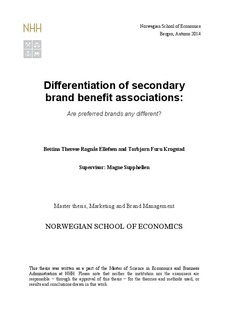| dc.description.abstract | The brand management literature focuses on differentiation of brand benefits. However,
associative network theory has taught us that associations do not have independent meaning,
but receive its content from surrounding nodes, i.e. secondary associations. Thus, we must
study secondary brand benefit associations (SBBAs) in order to learn more about
differentiation.
We compared the SBBAs of preferred and acceptable brands using a randomized 4 (car-,
beer-, grocery store- and clothing store categories) x 2 (preferred- and acceptable brands)
factorial between subjects design. Furthermore, we investigated whether the same effects
apply for products and services, thus providing a new and important contribution to the
research on differentiation. The experiment was conducted online, with a sample of 818
current and former students at the Norwegian School of Economics.
In accordance with the traditional view on brand differentiation, our experiment only
investigated SBBAs with positive valence. We focused on four dimensions of
differentiation: The first is the number of positive SBBAs. Secondly, instrumental
differentiation is specific evidence for why a brand is better than the competitors on a driver.
Finally, graded differentiation is to what extent a secondary association is shared with other
brands, where dichotomous differentiation implies that it is solely connected to the brand.
The results of our main study show that preferred brands had a higher number of positive
SBBAs for both products and services. While only services had preferred brands with a
higher score on instrumental- and graded differentiation. We also used regression analyses to
test whether our differentiation dimensions could explain any variance in evaluations of
brand benefits. Results showed that instrumental differentiation had a positive effect for
product brands, whereas graded differentiation had a positive effect for service brands. The
number of positive SBBAs had a positive effect for all brands, hence supporting the
traditional view on brand differentiation. | nb_NO |
